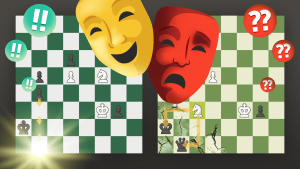
Requiem for a Romantic
Chess is a reflection of life. Our modern lives go faster and so too do the time controls we play today. When I tell kids that I played the so-called Capablanca's time control (two hours and 30 minutes for the first 40 moves) and then the game would be adjourned, I feel like a dinosaur. Our pragmatic age has affected the way we play chess as well. It is unimaginable for today's top players to sacrifice even a single pawn without a computer's approval.
So chess is different today from what the Royal Game used to be some 40 years ago. Therefore, you can imagine how sad I was when I heard the news that the famous Yugoslav grandmaster Dragoljub Velimirovic passed away last week. He was one of few remaining links to the "Golden Age" of chess.
Velimirovic was a strong chess player who won many international tournaments (you can see more info about his chess results here), but what he'll be remembered for is his attractive chess style. He played what Tal called "tasty chess" and naturally had many fans. Velimirovic was very popular in the fomer Soviet Union. So popular that super-GM Teimour Radjabov chose nickname 'Velimirovic' for his account on the Internet Chess Club.
I remember that, when I was a kid, I started playing the Modern Benoni influenced by Velimirovic's games. Modern Benoni and the Sozin Attack are two openings that cannot be separated from Velimirovic's name. Here are two typical episodes:
In the last round of the Interzonal tournament in Moscow, 1982, Garry Kasparov is playing Velimirovic. The game is pretty much irrelevant for Kasparov since he already guaranteed himself qualification to the Candidates matches, and yet Kasparov chose the ultra solid Caro Kann. Why would the World's biggest expert of the Najdorf variation chicken out from playing his favorite opening? Kasparov explains in his book: "Velimirovic really wanted to become the first Yugoslav to beat me, so I didn't risk playing the Sicilian."
Our next example occured in an international tournament in Habana, 1971. One of the biggest opening experts in the history of chess, GM Efim Geller, is playing Velimirovic, who at that point is leading with the perfect score after the first five rounds. In his book Geller explains the move order (1.Nf3 Nf6 2.c4): "This move order intended to prevent Velimirovic's favorite Modern Benoni."
Now let's see what made these two giants of the Soviet chess school avoid the direct confrontation with Velimirovic in his favorite openings.
One of the sharpest lines of the Sicilian Defense is named after Velimirovic, who developed the dangerous attacking set up when he wasn't even a master! The typical pattern there is White sacrifices his knight on the d5 or f5 squares and then brings his pieces and pawns for the decisive break, frequently playing "quiet" moves as if nothing really happened!
An entire chapter in Kasparov's book Revolution in the 70s is devoted to Velimirovic's opening heritage. There Kasparov explains that Velimirovic's chess contributions were not limmited to the "Velimirovic Attack" in the Sozin variation. One of the popular lines of the Najdorf Sicilian was entirely refuted by Velimirovic!
Kasparov calls some of the Velimirovic's sacrifices more "flashy" than strong. I think the reason was that, for Velimirovic, the beauty of the idea was more important then the final result. He was a typical Chess Romantic! Kasparov uses the following game as an example of the incorrect sacrifice:
So the sacrifice was incorrect, and Black could possibly refute it if he played the following half-dozen moves with computer precision. But if we use this logic, then we have to completely disregard the whole legacy of Mikhail Tal. Imagine that Velimirovic (or Tal for this matter) played perfect computer chess where unsound sacrifices, risk and sometimes pure bluff didn't exist. Who would benefit from this kind of "perfect" chess?
The chess heritage of Dragoljub Velimirovic is enormous and I plan to re-visit it again in the future. In conclusion I want to express my regret that a book of Velimirovic's best games was never published (at least I am not aware of it). It could have been a good tribute for a person who devoted his whole life to the creative side of chess!
RELATED STUDY MATERIAL
- Take a gander at IM Silman's The Mighty Benoni;
- Watch IM Mark Ginsburg's lecture Modern Benoni 1: The 'Amanovs' Thrilling Battle!;
- Shock your opponent's with the Velimirovic Attack in Chess Mentor;
- Maintain your tactical readiness in our Tactics Trainer;
- Looking for articles with deeper analysis? Preview our magazine: The Master's Bulletin.

